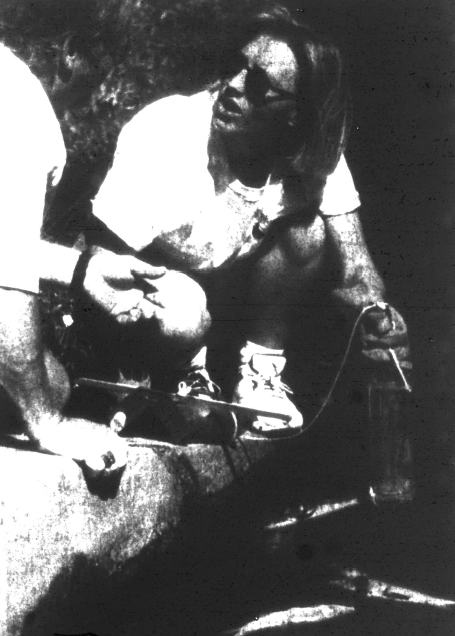Fish in Sunset Lake since the 1970s
June 9, 2010 by admin

Patsy Cicala, an environmental educator, prepares to test the dissolved oxygen content at Sunset Lake during the 1997 sewage spill. The test yielded a zero reading, meaning that no fish could have survived in the water.
After speaking with Vassar alumni about the changes in Sunset Lake I became curious about the history of fish in the Lake and stream.
Until the 1950’s Sunset Lake was periodically drained to supply cooling water for Vassar’s power generation plant. This process helped to keep the Lake from filling in with silt, and kept it clear and deep enough for trout and other sport fish. Once this practice was ended, the water quality of the lake began to decline. Rapid upstream development only contributed to the problem, and by the mid-1970s the once 7-9 feet deep Lake had become an extremely polluted 2 foot deep mud hole. The algal blooms began to get so bad that the Vassar Miscellany News ran a front-page article on September 12, 1975 declaring that “Sunset Lake Faces Extinction.” It was at about this same time that Lawrence N. Halfen, a professor of biology, led ecology and conservation studies of the Lake. He and his students found that the trout that once thrived in the Lake had all been replaced by “rough fish” that could more easily adapt to the smelly, shallow waters. In 1977, Halfen oversaw the Lake’s much-needed restoration, which cost upwards of $80,000.
Fish species diversity in Sunset Lake was again determined in 1992. At the time of that census, the lake was home to largemouth bass, black crappies, red-breasted sunfish, pumpkinseed sunfish, redfin pickerels, mosquito fish, white suckers, yellow bullheads, and goldfish.
Unfortunately, on August 7, 1997, Sunset Lake faced extinction again. An article on the first page of the Poughkeepsie Journal began:
Untreated sewage spilling from an Arlington Sewer District pipe spread an offensive odor across the Vassar College campus and killed more than a thousand fish in the college’s Sunset Lake.
Apparently vandals threw concrete blocks into the sewer line, blocking the normal flow of sewage and causing the overflow. The sewage spill quickly killed off all Casperkill biota downstream, as the influx of solid wastes took literally all of the dissolved oxygen out of the water. Fish, like humans, suffocate and die without oxygen.
After the dissolved oxygen crisis abated, Vassar Buildings and Grounds staff hired Northeastern Aquatics to restock the lake with golden shiners, brown and yellow bullheads, bluegills, pumpkinseeds, largemouth bass, and redfin pickerels. It is unknown which species currently occupy the lake and stream, but I have been told by several professors that the Lake is due for another dredging.
Information and image from:
Kipp, Dennis. “Sewage kills 1,000-plus fish.” The Poughkeepsie Journal 8 Aug. 1997: A1.
Other information from:
The Casperkill Assessment Document: Vassar College Environmental Research Institute, 2009. Health of the Casperkill, Dutchess County, New York.
The Vassar College Encyclopedia (http://vcencyclopedia.vassar.edu/buildings-grounds/grounds/sunset-lake.html)